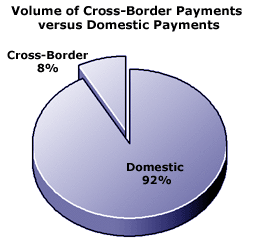Cross-Border Business-to-Business Payments: The New Frontier
Abstract
Boston, MA, USA October 29, 2004
Celent estimates that cross-border payments represent approximately 8 percent of total payment volume. While many large banks have already invested in cross-border payments as well as trade finance, there is still room for growth. Banks must offer cross-border payment capabilities to remain competitive and meet the requirements of increased global trade.
 B2B cross-border payments are not a revolutionary concept; corporations have been transferring funds both domestically and internationally for some time. However, as markets become increasingly global, there is a pressing need to fulfill the requirements of corporations participating in cross-border trade as well as the financial institutions that serve them.
B2B cross-border payments are not a revolutionary concept; corporations have been transferring funds both domestically and internationally for some time. However, as markets become increasingly global, there is a pressing need to fulfill the requirements of corporations participating in cross-border trade as well as the financial institutions that serve them.
In a new report, , Celent provides an overview of this market. The report examines the market for business-to-business cross-border payments and reviews opportunities and challenges faced by corporations and financial institutions. It looks at how banks can work to achieve competitive advantage by using the Internet and Web-based technologies. The report also examines European, North American, and global cross-border initiatives and takes an in-depth look at emerging standards organizations.
Multiple payment vehicles (e.g., checks, purchasing cards, ACH, and wire transfer), networks, and standards have risen up to provide a dizzying array of options. Additionally, technological, political, geographic, regulatory, and competitive changes are transforming the cross-border payment process and landscape. These transformations are providing significant opportunities, challenges, and risks to corporations and financial institutions.
"Cross-border business-to-business payment systems need to provide a net benefit to all parties involved幼orporations, banks and central banks, standards organizations, technology providers, and others," says
Jacob Jegher, senior analyst in Celent's banking group and author of the report. "For these solutions to evolve and provide tangible benefits, a long-term vision and spirit of collaboration is required. True collaborative efforts between banks and corporations will give rise to improved cross-border payment systems using newly defined standards. These initiatives will slowly diffuse physical borders and will support the rise in global trade."
Celent asserts that while many banks have already invested in cross-border payments as well as trade finance, there is still room for growth. Technology to create a one-stop payments shop will become commonplace, and banks will have to offer such a service. Over time, the availability and features of these payment solutions will become commoditized, and the payment process itself will lack competitive differentiation. Competitive advantage for financial institutions will come in the form of all-encompassing electronic financial supply chain solutions.
This 39-page report contains 13 figures and 10 tables. A
table of contents is available online.
of Celent Communications' Wholesale Banking research service can download the report electronically by clicking on the icon to the left. Non-members should contact info@celent.com for more information.
|

